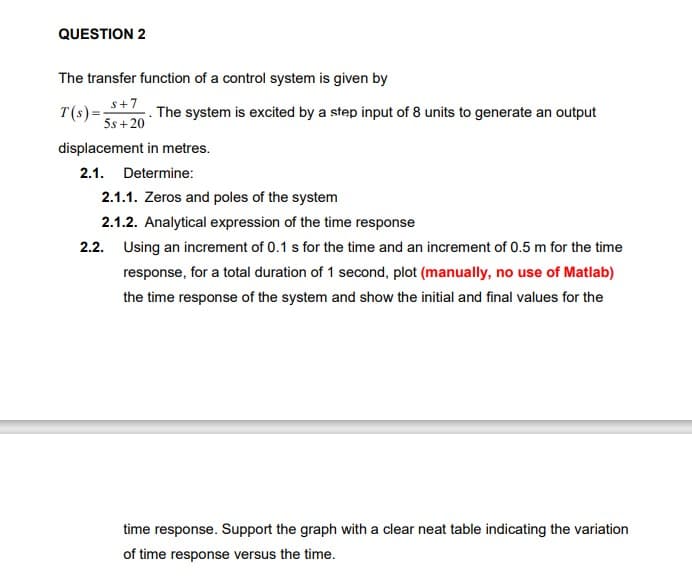The transfer function of a control system is given by s+7 5s +20 T(s) = The system is excited by a step input of 8 units to generate an output displacement in metres. 2.1. Determine: 2.1.1. Zeros and poles of the system 2.1.2. Analytical expression of the time response 2.2. Using an increment of 0.1 s for the time and an increment of 0.5 m for the time response, for a total duration of 1 second, plot (manually, no use of Matlab) the time response of the system and show the initial and final values for the
The transfer function of a control system is given by s+7 5s +20 T(s) = The system is excited by a step input of 8 units to generate an output displacement in metres. 2.1. Determine: 2.1.1. Zeros and poles of the system 2.1.2. Analytical expression of the time response 2.2. Using an increment of 0.1 s for the time and an increment of 0.5 m for the time response, for a total duration of 1 second, plot (manually, no use of Matlab) the time response of the system and show the initial and final values for the
Introductory Circuit Analysis (13th Edition)
13th Edition
ISBN:9780133923605
Author:Robert L. Boylestad
Publisher:Robert L. Boylestad
Chapter1: Introduction
Section: Chapter Questions
Problem 1P: Visit your local library (at school or home) and describe the extent to which it provides literature...
Related questions
Question

Transcribed Image Text:QUESTION 2
The transfer function of a control system is given by
s+7
T(s) =
5s + 20
The system is excited by a step input of 8 units to generate an output
displacement in metres.
2.1. Determine:
2.1.1. Zeros and poles of the system
2.1.2. Analytical expression of the time response
2.2. Using an increment of 0.1 s for the time and an increment of 0.5 m for the time
response, for a total duration of 1 second, plot (manually, no use of Matlab)
the time response of the system and show the initial and final values for the
time response. Support the graph with a clear neat table indicating the variation
of time response versus the time.
Expert Solution
This question has been solved!
Explore an expertly crafted, step-by-step solution for a thorough understanding of key concepts.
Step by step
Solved in 3 steps with 1 images

Recommended textbooks for you

Introductory Circuit Analysis (13th Edition)
Electrical Engineering
ISBN:
9780133923605
Author:
Robert L. Boylestad
Publisher:
PEARSON

Delmar's Standard Textbook Of Electricity
Electrical Engineering
ISBN:
9781337900348
Author:
Stephen L. Herman
Publisher:
Cengage Learning

Programmable Logic Controllers
Electrical Engineering
ISBN:
9780073373843
Author:
Frank D. Petruzella
Publisher:
McGraw-Hill Education

Introductory Circuit Analysis (13th Edition)
Electrical Engineering
ISBN:
9780133923605
Author:
Robert L. Boylestad
Publisher:
PEARSON

Delmar's Standard Textbook Of Electricity
Electrical Engineering
ISBN:
9781337900348
Author:
Stephen L. Herman
Publisher:
Cengage Learning

Programmable Logic Controllers
Electrical Engineering
ISBN:
9780073373843
Author:
Frank D. Petruzella
Publisher:
McGraw-Hill Education

Fundamentals of Electric Circuits
Electrical Engineering
ISBN:
9780078028229
Author:
Charles K Alexander, Matthew Sadiku
Publisher:
McGraw-Hill Education

Electric Circuits. (11th Edition)
Electrical Engineering
ISBN:
9780134746968
Author:
James W. Nilsson, Susan Riedel
Publisher:
PEARSON

Engineering Electromagnetics
Electrical Engineering
ISBN:
9780078028151
Author:
Hayt, William H. (william Hart), Jr, BUCK, John A.
Publisher:
Mcgraw-hill Education,